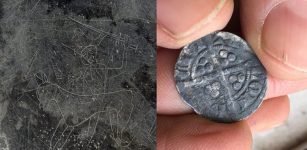Ship-Shaped Burial Of Tjelvar – Legendary First Man Who Brought Fire To Gotland
A. Sutherland - AncientPages.com - Tjelvar's tomb is a ship set from the Bronze Age located near the east coast of Gotland and almost directly east of Visby, in the parish of Boge on the island.
Tjelvar's burial site is 18 meters long and 5 meters wide. In the Late Bronze Age, around 1100 – 500 BC, graves were built in the form of ships with relays of erected stones. There are about 350 such graves on Gotland; traditionally, only one grave is found in each ship set.
The length of the ships usually varied. However, often, several ship sets were adjacent to each other. Sometimes they were even built together with common stones in the fore or aft.
Tjelvar's grave is not as famous as the enigmatic Ales Stenar (in English, Ale's Stones), often referred to as Sweden's Stonehenge of The North'.
The Ale's Stones constitutes Sweden's largest remaining stone ship, and this kind of stone circle date back to the Bronze or Iron Age. Building ship-shaped burial was widespread during the Bronze Age.

Are Ale's Stones a monument to a Viking chieftain, Olav Tryggvasson, who was buried on this ridge together with his ship? Read more
Tjelvar's tomb is 18 meters long and 5 meters wide, with gunwale stones that subside towards the boat's center. Inside, the ship is filled with stone like a built-up boat deck. It is believed that the grave dates back to the Late Bronze Age (1100–500 BC).
When it was restored in 1938, a small coffin made of stone slabs was found, but it was plundered long ago, and it only contained a few potsherds and some burnt bones.
Legendary Tjelvar Is Mentioned In ‘Gutasaga’
Many believe he was a legendary figure. According to the 13th-century 'Gutasaga,' Tjelvar was the first to set foot on Gotland. Tradition has it that Gotland at that time was so 'bewitched' that in the daytime, it sank, and at night it stood up.
Tjelvar's tomb. Image credit: Char55lotte - CC BY-SA
Tjelvar brought the fire to the island, and miraculously the island stopped sinking into the sea during the day, according to the old 'Gutasaga.'
No one knows when the first people came to Gotland, but the oldest skeleton found is after a man who lived on the island about 8,000 years ago.
Ancient people have performed ceremonies at landings at all times, and through the Icelandic sagas, we learned that during the Viking Age, fire was used to limit a land area. No one was allowed to take a more significant place than he and his men could burn off in one day. It was a deeply respected tradition.
It is said that Tjelvar lived on the farm in Boge, and then he was buried there in a boat-shaped grave.
In the vicinity of Tjelvar's grave, two hillforts are possibly dated to the Iron Age. For protection, they were most probably reinforced with walls. Wooden palisades may have crowned walls and ramparts.
Illustration of hillfort. Image credit: Ulla Sjöswärd
The 'Gutasaga,' which mentions Tjelvar, is a Gotland chronicle about the island's early history before Christianity arrived. This literary work survived in only a single manuscript, which, together with the Gotland legal code- the medieval Gotland law book - is known as 'Gutalag.'
It forms part of the Codex Holm (now held in the royal library in Stockholm).
Ancient Viking funeral traditions and rituals were very complex. Vikings lived in a hierarchical society, and ancient tombs reveal that the type of burial a Viking received depended on his importance in the community.
When a Viking died, he could either be buried or burned. Ship burials were rare, and they were only reserved for great Viking warriors whose dead body was placed on a ship that sailed out to the sea and was set on fire.
The Vikings were the lords of the oceans. Credit: Vlastimil Sesták - Adobe Stock
Vikings who were not as influential could be burned. Cremation was relatively common during the early Viking Age.
Vikings' burial customs depended on the region where they lived, but their ships were always admired and respected.
One of the main reasons behind the Vikings' success in reaching distant lands lies in their remarkable longships. The Vikings' ships were the European Dark Ages' most outstanding technical and artistic achievement. Without these great ships, the Viking Age would never have happened. It's, therefore, understandable that burials were deliberately constructed in the image of the ship.
As old historical sources explain, Tjelvar's arrival changed the history of Gotland, and he deserved to be put to rest in a shaped grave.
Written by – A. Sutherland - AncientPages.com Senior Staff Writer
Updated on May 30, 2023
Copyright © AncientPages.com All rights reserved. This material may not be published, broadcast, rewritten or redistributed in whole or part without the express written permission of AncientPages.com
Expand for referencesMore From Ancient Pages
-
 Rare Viking Graffiti And Artifacts Found In Dublin – Depiction Of God Odin Riding Sleipnir Followed By Huginn And Muninn?
Archaeology | Mar 31, 2018
Rare Viking Graffiti And Artifacts Found In Dublin – Depiction Of God Odin Riding Sleipnir Followed By Huginn And Muninn?
Archaeology | Mar 31, 2018 -
 Puzzling Sakwala Chakraya Carving Could Be World’s Oldest Map Of The Universe – Mystery Of Sri Lanka’s Stargate
Featured Stories | May 15, 2021
Puzzling Sakwala Chakraya Carving Could Be World’s Oldest Map Of The Universe – Mystery Of Sri Lanka’s Stargate
Featured Stories | May 15, 2021 -
 On This Day In History: First Siege Of Rome Began – On March 2, 537
News | Mar 2, 2017
On This Day In History: First Siege Of Rome Began – On March 2, 537
News | Mar 2, 2017 -
 Large Mammoth Tusk And Bones Buried For Thousands Of Years Found In North Dakota
News | Jan 8, 2024
Large Mammoth Tusk And Bones Buried For Thousands Of Years Found In North Dakota
News | Jan 8, 2024 -
 Surprising Discovery Of A Perfectly Ancient Road Shows Romans Moved Deeper Into Wales Than Previously Thought
Archaeology | Jul 2, 2022
Surprising Discovery Of A Perfectly Ancient Road Shows Romans Moved Deeper Into Wales Than Previously Thought
Archaeology | Jul 2, 2022 -
 Giant Bath Tub Built For Tsar Alexander I – Why Was It So Large?
Featured Stories | Jul 11, 2018
Giant Bath Tub Built For Tsar Alexander I – Why Was It So Large?
Featured Stories | Jul 11, 2018 -
 Upside Down Chambers For The Dead Found At Maeshowe, Orkney
Archaeology | Sep 8, 2020
Upside Down Chambers For The Dead Found At Maeshowe, Orkney
Archaeology | Sep 8, 2020 -
 Stunning Reconstruction Of Caterthun Iron Age Forts In The Grampian Mountains, Scotland
Civilizations | Nov 17, 2016
Stunning Reconstruction Of Caterthun Iron Age Forts In The Grampian Mountains, Scotland
Civilizations | Nov 17, 2016 -
 On This Day In History: Berlin Victory Parade Took Place – On September 7, 1945
News | Sep 7, 2016
On This Day In History: Berlin Victory Parade Took Place – On September 7, 1945
News | Sep 7, 2016 -
 9,000-Years-Old Underwater Artifacts Found Off The Western Australia Pilbara Coast – Protect Flying Foam Passage Scientists Say
Archaeology | Jun 27, 2023
9,000-Years-Old Underwater Artifacts Found Off The Western Australia Pilbara Coast – Protect Flying Foam Passage Scientists Say
Archaeology | Jun 27, 2023 -
 Teens Make Incredible Discovery In An Ancient Florida Cave
Featured Stories | Mar 15, 2024
Teens Make Incredible Discovery In An Ancient Florida Cave
Featured Stories | Mar 15, 2024 -
 ‘Curious’ Creature With No Anus Is Not Earliest Human Ancestor – Relieved Scientists Discover
Archaeology | Aug 18, 2022
‘Curious’ Creature With No Anus Is Not Earliest Human Ancestor – Relieved Scientists Discover
Archaeology | Aug 18, 2022 -
 Discovery Of Fortified Villages And Earthworks Re-Writes Ancient History Of Amazon
Archaeology | Mar 29, 2018
Discovery Of Fortified Villages And Earthworks Re-Writes Ancient History Of Amazon
Archaeology | Mar 29, 2018 -
 Ancient Murals Of Mysterious Two-Faced Beings And Supernatural Creatures At Pañamarca, Peru
Archaeology | Mar 21, 2023
Ancient Murals Of Mysterious Two-Faced Beings And Supernatural Creatures At Pañamarca, Peru
Archaeology | Mar 21, 2023 -
 Newly Discovered Papyrus Reveals An Intriguing And Gripping Criminal Case From The Roman Empire
Archaeology | Jan 29, 2025
Newly Discovered Papyrus Reveals An Intriguing And Gripping Criminal Case From The Roman Empire
Archaeology | Jan 29, 2025 -
 2,500-Year-Old Olmec Related Mexican Cave Paintings Are Now Restored And Protected
Civilizations | Sep 18, 2015
2,500-Year-Old Olmec Related Mexican Cave Paintings Are Now Restored And Protected
Civilizations | Sep 18, 2015 -
 Does A Baffling Artifact Offer Evidence Of Ancient Extraterrestrial Visitation In New Zealand? – Experts Investigate – Part 2
Ancient Mysteries | Jul 23, 2020
Does A Baffling Artifact Offer Evidence Of Ancient Extraterrestrial Visitation In New Zealand? – Experts Investigate – Part 2
Ancient Mysteries | Jul 23, 2020 -
 ‘Surprisingly Large’ Extinct Lemurs Shows Fascinating Similarities To Human Fossils
Archaeology | Dec 14, 2022
‘Surprisingly Large’ Extinct Lemurs Shows Fascinating Similarities To Human Fossils
Archaeology | Dec 14, 2022 -
 World’s Oldest Dictionaries Are 4,500-Year-Old Cuneiform Tablets Discovered In Ebla
Ancient History Facts | Aug 19, 2016
World’s Oldest Dictionaries Are 4,500-Year-Old Cuneiform Tablets Discovered In Ebla
Ancient History Facts | Aug 19, 2016 -
 Hypocaust – First Central Heating Invented By Ancient Romans 2,000 Years Ago
Ancient History Facts | Jan 14, 2018
Hypocaust – First Central Heating Invented By Ancient Romans 2,000 Years Ago
Ancient History Facts | Jan 14, 2018




